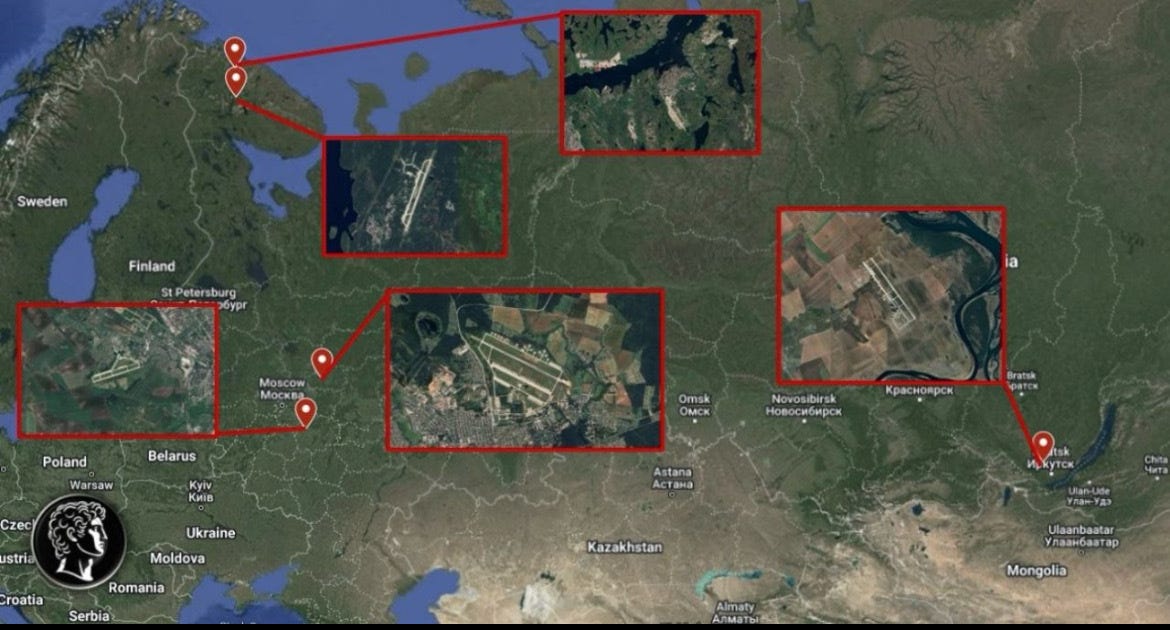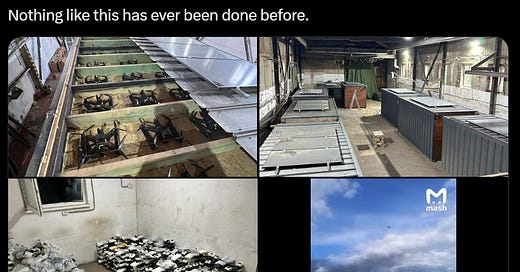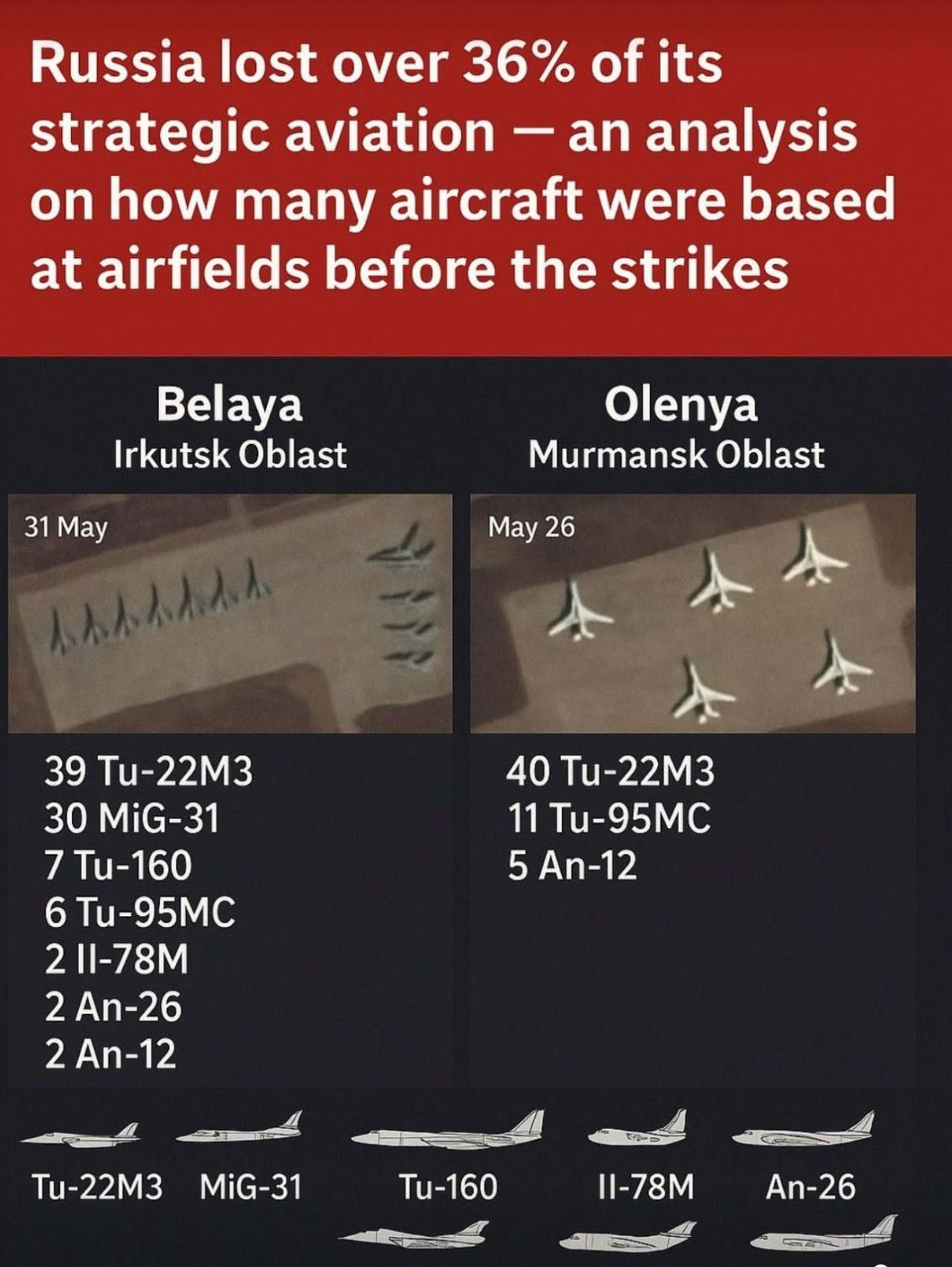"Russia's Pearl Harbor"
Operation Spider Web strike targets Russian Nuclear Infrastructure//my appearance on the Drone Wars Podcast
I was on this week’s Drone Wars Podcast with Dan Magy from Firestorm talking about CX2 and the current state of play in the UAS and counter-UAS space. It’s a two part episode so be sure to tune in for the rest of it, where I also talk about “Gundo” and the challenges of finding and cultivating talent and building startups. You can watch on Youtube below or listen on Spotify or Apple Podcast (sorry in advance for the congestion, I was fighting a terrible headcold):
Now onto this week’s news of a Ukrainian massive drone sneak attack behind Russian lines, with familiar themes like penetrating enemy supply and logistics chains and using them against them like Israel’s devastating attacks on Hezbollah last year and leveraging drones launched from Shipping Containers as we talked about in the penultimate edition of this Substack.
A Daring Sneak Attack From Behind Enemy Lines
Dubbed Operation Spider Web, the Ukrainians appear to have pulled off a quite daring assault with targets as far east as Siberia, with some sources claiming as much as 1/3 of it’s strategic airpower may have been destroyed. Here’s some amazing video of the strikes underway shot from one of the FPV drones participating in it (note the use of truck tires on the wings as camouflage and to confuse automatic target recognition algorithms from drones and overhead satellites):
Early reports are saying five bases, including a submarine base and four air bases were hit. The BBC reports (map below shows the sites)):

“Sources in the SBU earlier on Sunday told the BBC in a statement that four Russian airbases - two of which are thousands of miles from Ukraine - were hit:
Belaya in Irkutsk oblast (region), Siberia
Olenya in Murmansk oblast, Russia's extreme north-west
Dyagilevo in central Ryazan oblast
Ivanovo in central Ivanovo oblast”
There are additional reports include the city of Severomorsk (also in the Northern province of Murmansk) and home to nuclear submarines was on the list, but have yet to be confirmed. The targeting of Russian strategic nuclear delivery sites is a major escalation but shows that the Ukrainians are off the NATO/US leash. Perhaps even more upsetting for the Russians, many of these assets such as Tu-95 Bears (seen in the video above) and A-50 Mainstay AWACS aircraft are irreplaceable as their production lines were long since shuttered.
Order of Battle
Ukrainian officials are reporting that this operation took over a year to plan and carry out, with offices even set up across from FSB (Russian Intelligence) headquarters in some regions. Drones were brought in through Kazakhstan along with wooden crates used to build launchers and final assembly reportedly took place in Chelyabinsk near the Kazakh border, according to Russian reports. SBU (Ukrainian intelligence) sources describe the whole operation as extremely logistically complex: "The SBU first smuggled FPV drones into Russia, followed later by mobile wooden cabins. Once on Russian territory, the drones were hidden under the roofs of these cabins, which had been placed on cargo vehicles…At the right moment, the roofs were remotely opened, and the drones took off to strike the Russian bombers."
Some pictures have been leaked by SBU of this being mechanized. Apparently Russian truck drivers were completely oblivious as to the contents of the trucks, only to be redirected in route by an unknown caller on where to stop and where to park…hmm.
In case you’re wondering what the final drones look like in attack configuration: Richard Woodruff is holding one below: a 15” drone with an RPG-7 based warhead and COGS cost of about $430.
Using their own cell networks against them
Scattered reports by Russian Military Bloggers on Telegram indicate that the Ukrainians bypassed the need for ground stations in favor of LTE modems to connect directly to the internet via the Russians own cellular networks:
For those of your who don’t speak fluent Russian (thanks ChatGPT):
“All of this could have been avoided — if mobile internet had been disabled in time ❗
Now, regarding today’s screw-up from a technical point of view:
The FPV (first-person view) control was carried out via mobile networks (4G, LTE, and the like). The bandwidth of modern mobile networks is more than sufficient to handle such tasks.
There were no ground control stations, let alone any sabotage operators, nearby. The truck driver specifically, and the logistics chain as a whole, is a separate matter that our security services will need to investigate.
The FPV drone was controlled using a software-hardware solution (system) called ARDUPILOT. The exact same setup is used on “Baba Yagas” (a nickname for certain drones), except instead of a Starlink terminal, there's an LTE modem with an Ethernet output, which connects to a single-board PC like a Raspberry Pi or Orange Pi. A webcam is connected to the PC, streaming video, and control commands are transmitted to the drone via the ArduPilot UART channel.
ArduPilot is used on platforms that require flight stabilization and maximum autonomy in control — including under conditions with high latency in the operator-drone or drone-operator communication channel. In other words, this exact setup was chosen because the operation was conducted over internet channels.
The brilliance of this operation lies not in any technical uniqueness (both sides of the conflict use such solutions), but in the organizational-logistical aspect — amplified by total local-level sloppiness when it comes to providing even basic security measures.”
Baba Yaga’s use Starlink to serve as a relay for deep strike drones that communicate directly through two way radio link (The Baba Yaga is a Ukrainian Group II drone built by CX2 partner Skyfall.) The use of cellular networks such as 4G and LTE to communicate with drones directly through the internet, potentially putting the operator anywhere in the world but on the battlefield has been a potential nightmare scenario for many years and one I touched on in a previous post. LTE modem kits for drones are now readily available through vendors such Sky Drone, DJI and ElSight. Rumors are that the Ukrainians held “LAN parties” from thousands of miles away with all the 117 or so pilots in the same room to better coordinate strikes!
It’s highly likely that the Russians will spend a large portion of the next few weeks trying to figure out how to install some sort of “kill switch” into cell stations near targets of military interest, so this may not work forever. It’s hard to fall for the Trojan Horse ruse twice.
Aftermath
“This is exactly what wars of the future will look like.” - Iryna Vereshchuk, a top official in Ukrainian President Volodymyr Zelensky’s office
Based on preliminary intelligence, the operation seems to have had a devastating impact on Russia’s limited fleet of strategic bombers, destroying as much as 36%. We’ll keep an eye out as the pencil gets sharpened on this.
SAR imagery from commercial satellites confirms some of the damage, showing at least 4 Tu-95s destroyed at Belaya field:
Both sides appear to be escalating, with the Ukrainians reporting immediate follow up strikes into Russian and Russian occupied areas by more drones and the Russians launching overnight drone strikes into Zaporizhzhia . It’s unclear how Russia will escalate any further, particular if a large portion of it’s strategic bomber fleet is neutralized. What is certain is that much like the weather, summer is heating up.
Wrapping it up
US military planners are likely watching and taking notes, it’s not much of an imagination to change Russian names on crates for Chinese ones, and boats for ships, as seen in the graphic below:
Indeed, it was only a few years ago that science fiction outlined the nightmare scenario no one wants to think about: the same sorts of drone swarms striking on US soil:
Hopefully US force planners are taking whatever plans they had for Golden Dome and thinking about reprogramming some of it for internal UAS defense, because as we just saw in Russia, $7B in priceless equipment can dissappear from a surprise attack from 150 drones in a few minutes anywhere in your territory if you aren’t prepared to stop them.











